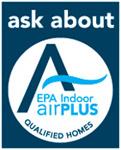Take Action for Climate Readiness and Indoor Air Quality
You can take several steps to help maintain a healthy indoor air environment as we adapt to the challenges of climate change. Good indoor air quality starts with the construction and repair of the buildings we live and work in — good ventilation, reduction of pollutants, energy efficiency — and continues with public awareness of key steps that can be taken to maintain a healthy indoor environment and prevent exposure to high levels of indoor contaminants.
On this page:
Consumers
Many of the steps you can take to improve indoor air quality at home will help resolve multiple problems at once.
- Control moisture and limit mold growth. You can manage indoor humidity by venting appliances that produce moisture to the outside. Use air conditioners and dehumidifiers when needed, and clean up water leaks and spills quickly. You can find more information about preventing mold and guidelines for cleaning mold on EPA’s Mold Website.
- If you are in the market for a new home, consider a home that has earned the ENERGY STAR and the Indoor airPLUS label. ENERGY STAR qualified homes are significantly more energy efficient than standard homes. Indoor airPLUS is an additional label that only ENERGY STAR homes can earn for including features to help protect against moisture and mold, pests, combustion gases and other airborne pollutants.
- Make sure you have proper ventilation in an existing home or a new home you are having built. EPA’s Guide to Indoor Air Quality has information about weatherizing your home and maintaining fresh air ventilation. The ENERGY STAR Home Improvement Website also has tips to help you seal and insulate your home and save energy. Consider working with a contractor to determine the best ways to maintain a comfortable indoor environment and improve ventilation in your existing or new home.
- Learn about other indoor air pollutants — carbon monoxide, secondhand smoke and pesticides — on EPA’s Indoor Air Quality Website and share the information with your neighbors.
- Find EPA’s answers to frequent questions about the science of climate change, its effects and greenhouse gas emissions.
Builders and Building Operators
- The risks of radon exposure are significantly decreased with proper construction techniques. The radon-resistant new construction, or RRNC Website includes information on building a home with radon resistant features. You can also find a builder that uses RRNC techniques in the RRNC Builder Directory.
- Residential builders can look to the specifications for Indoor airPLUS and ENERGY STAR New Homes and to build the healthy, energy-efficient homes that consumers are demanding. Homes that have earned the ENERGY STAR are significantly more energy efficient than standard homes. Indoor airPLUS is an additional label only ENERGY STAR qualified homes can earn and includes more than 30 home design and construction features that decrease the risk of poor indoor air quality. Key features of Indoor airPLUS address:
- moisture
- radon
- heating, cooling and ventilation
- combustion
- materials
- pests
- If you’re helping renovate an existing home, look to the ENERGY STAR Home Improvement Website for more information about sealing, insulating and fresh-air ventilation. The site offers a variety of resources contractors you can utilize to make homes perform better.
- Building owners and facility managers can learn more about factors that contribute to poor building air quality and how to address them on EPA’s Building Air Quality Guide.

